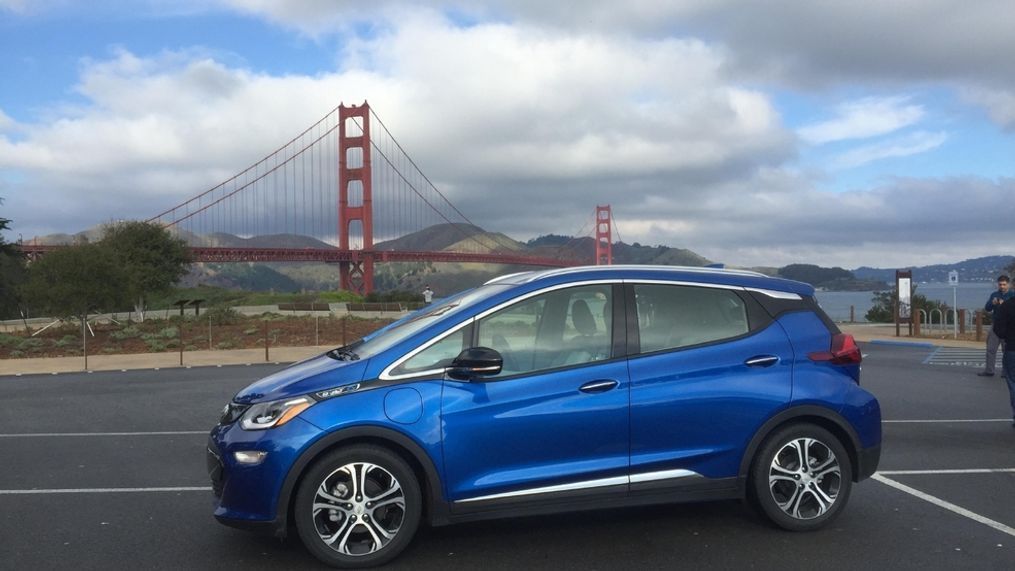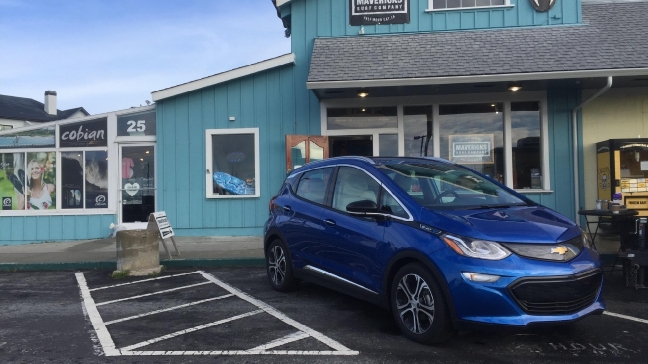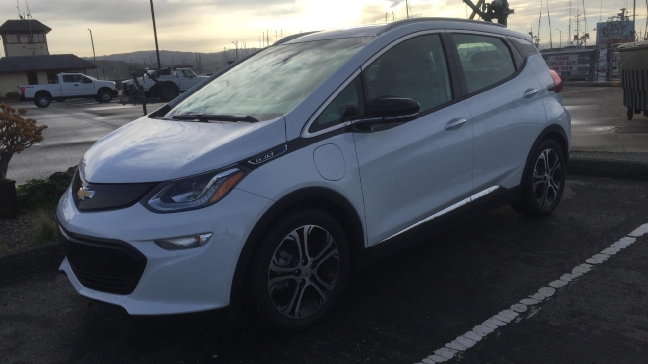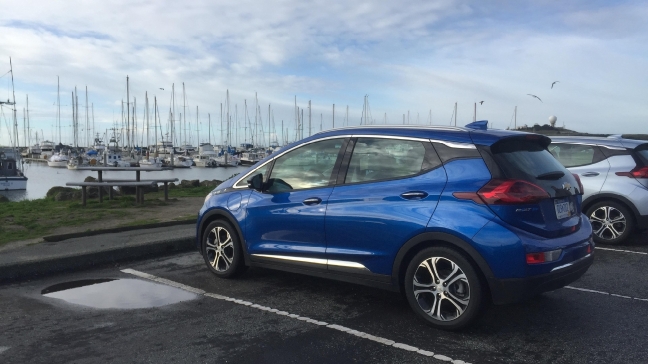2017 Chevrolet Bolt EV: A true electric car for the masses [First Look]
SAN FRANCISCO, Calif. — The first thing that strikes you when you drive the all-new Chevrolet Bolt EV is the silence. The absence of sound – both from the engine and exterior sources – is encompassing and kind of soothing. Which doesn’t quite prepare you for the punch of power you get from the instantaneous 266 pound-feet of torque.
The second thing you’ll notice: You don’t actually need to use the brake. If you’ve ever driven a golf cart, the idea isn’t completely unfamiliar, but it’s still kind of weird in a 3,563-pound vehicle. One-pedal driving is possible through a regenerative braking system that enables the vehicle to slow down just by taking your foot off the accelerator. You need to have the vehicle in “Low” mode or use the “Regen on Demand” paddle on the steering wheel, but as you decrease pressure on the accelerator, the car slows down – just like you’re hitting the brakes.
However, the 238-mile all-electric range is probably the biggest story here. That and the fact that it costs $30K less than the only comparably ranged EV currently on the market.
It doesn’t hurt that the Bolt EV is also a great car. It’s quick, fun-to-drive, quiet and surprisingly comfortable for such a small vehicle.
To say I liked it is an understatement.
It’s finally an electric car real people can own.
Sure, the base price for the Bolt EV is officially $37,495, but it does qualify for the $7,500 federal tax credit, which brings the “price tag” down to a more manageable sub $30K. When you consider that the average purchase price for a new car these days is about $34K, even the original $37K doesn’t seem that bad.
What I really liked about the Bolt EV, though, is the complete lack of range anxiety I felt while driving it. We started at 8 a.m. and drove through about noon. We had a couple of pit stops along the way and covered about 75 miles. We did not try to conserve energy, and we drove comfortably at highway speeds. We even turned on the heat. But still, had we the inclination, the car told us we could have gone another 125 miles before needing to charge.
Bolt EV comes standard with Level 2 charge capability, and you can purchase a home charger directly from Chevrolet for $699. DC fast charging capability is also an available option ($750) for those who might want to take a road trip and charge on the go.
The downer, however, is that the lack of infrastructure still limits your true mobility – even in an amazing vehicle like the Bolt EV. Sure you may be able to go for a full week without charging, but you couldn’t drive from Chicago to Detroit in the Bolt EV because of a lack of charging stations along the route.
According to a General Motors spokesman, the automaker has no plans to help build the infrastructure to support its first all-electric vehicle, but the automaker’s belief is that with building a “compelling electric vehicle” the infrastructure will naturally continue to expand rapidly.
The Bolt EV is currently available in California and Oregon, where infrastructure isn’t an issue. It will be available in all states starting in September, so it’ll be interesting to see the take rate where infrastructure is lacking and if there is any growth in charging stations due to increased demand.
The Bolt EV is available in two well-equipped trims, both of which are front-wheel drive models and come with available DC fast charge capability:
- LT ($37,495): Standard features on this base model include 17-inch aluminum wheels, HID headlamps, rearview camera, “Regen on Demand” paddle, keyless entry, push-button start, Apple CarPlay and Android Auto, a 10.2 inch color touch screen display and dual front USB ports.
- Premium ($41,780): This up-level trim adds features such as front and rear heated seats, heated steering wheel, surround vision rearview camera, ambient lighting on the instrument panel, blind spot monitoring, rear cross-traffic alert, rear park assist, rear camera mirror and a false cargo floor in the trunk area.
We were driving Premium trimmed vehicles during the press preview, and I appreciated both the heated seats and steering wheel in the chilly San Francisco clime. I liked the interior fit and finish, which has a nice mix of sturdy and high-tech elements. The 10.2-inch screen on the center stack is gorgeous and serves as a beautiful display for the standard Apple CarPlay and Android Auto. I also thought the purple ambient light that streaks across the dash in the dark was kind of cool.
I played around with Apple CarPlay a bit during the drive, and the program is still a bit glitchy, which is more likely due to Apple than Chevrolet. Switching back and forth between car and phone systems isn’t seamless, and sometimes if you want to listen to the radio but use a function of CarPlay, the system gets confused.
It is important to note that Chevrolet does not offer navigation on the Bolt EV, but with standard CarPlay and Android Auto, the display screen will mirror your phone’s map and navigation directions. Which is great if you’re using Google maps on Auto, but not so great if you’re using Apple maps on CarPlay.
The Bolt EV has a smooth ride for a compact car, and it did well in all kinds of driving situations – from curvy bits to stop-and-go city traffic. It also did well during passing maneuvers on the highway. Plus, I never felt like I was driving an oversized golf cart – Bolt EV feels like a “normal” car in every sense of the word.
But it’s exceptional in that I didn’t feel the need to scrimp on the heat or coast below the speed limit because I was concerned about range.
Depending on the kind of charging station an owner is using, the Bolt EV can hit a full charge in as little as 2 hours (Level 3, DC fast charge) or just more than 54 hours (Level 1, a regular wall jack). If you have a home charger, that’s considered Level 2, and a Bolt EV will fully charge in just more than 9 hours – perfect for overnight.
Living in an apartment, I never thought I could own an electric car. I don’t have a home charging station. I don’t have a work charging station. Most of the fast-charge stations I have access to are in a Walgreens or Whole Foods parking lot. And, frankly, I don’t need that many pharmaceuticals or groceries.
But with the 2017 Chevrolet Bolt EV, I can actually see the possibility of charging up once a week with Sunday mornings spent at Whole Foods reading the news at one of the food counters while sipping on some coffee and then getting some grocery shopping done before heading home.
Electric cars like the Nissan Leaf ($31,545) and Kia Soul EV ($34,845) are great for people who don’t live in a cold climate or who drive less than 80 miles a day, which is about the max you’ll be able to drive either vehicle before range anxiety sets in.
But the Bolt EV doesn’t have to compromise. Turn on the heat. Drive 100 miles. Feel free to “gun it” when you pass. And you’ll still make it home with plenty of charge.
Editor’s Note: Driving impressions in this “First Look” review are from an invitation-only automaker launch event that allowed special access to the vehicle and executives. Chevrolet covered our accommodations, meals and transportation costs.
_______________________________________
To find your next new, used or certified vehicle visit www.driveautonow.com today. Local car shopping made easy!




